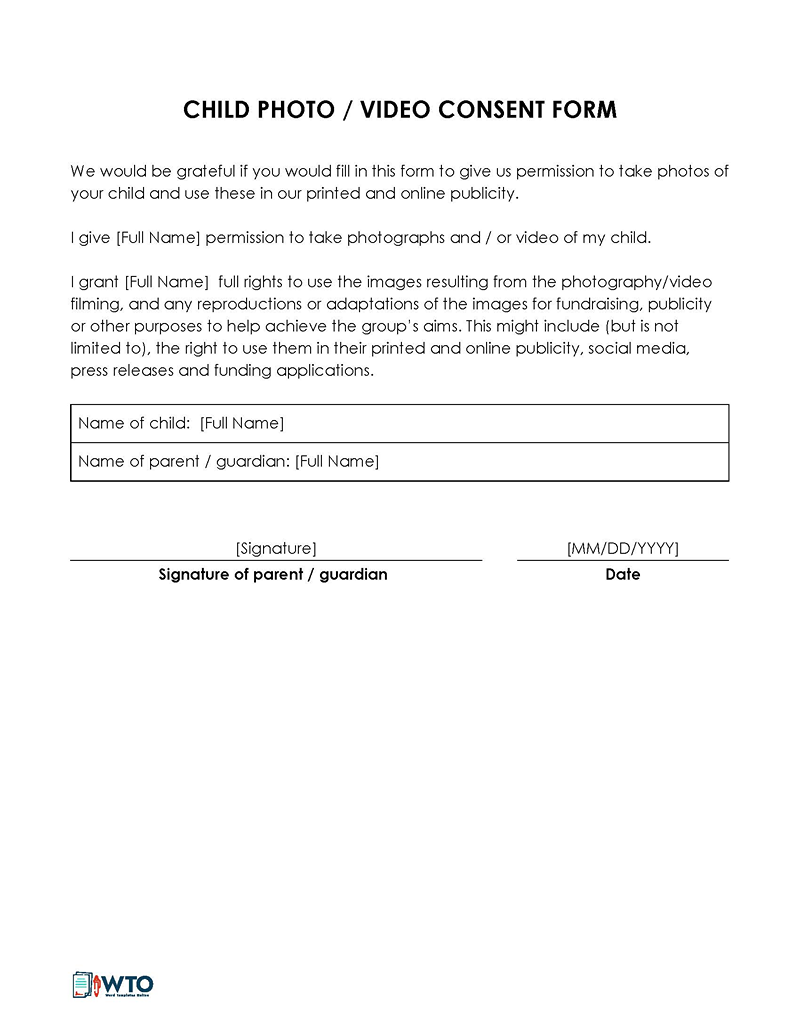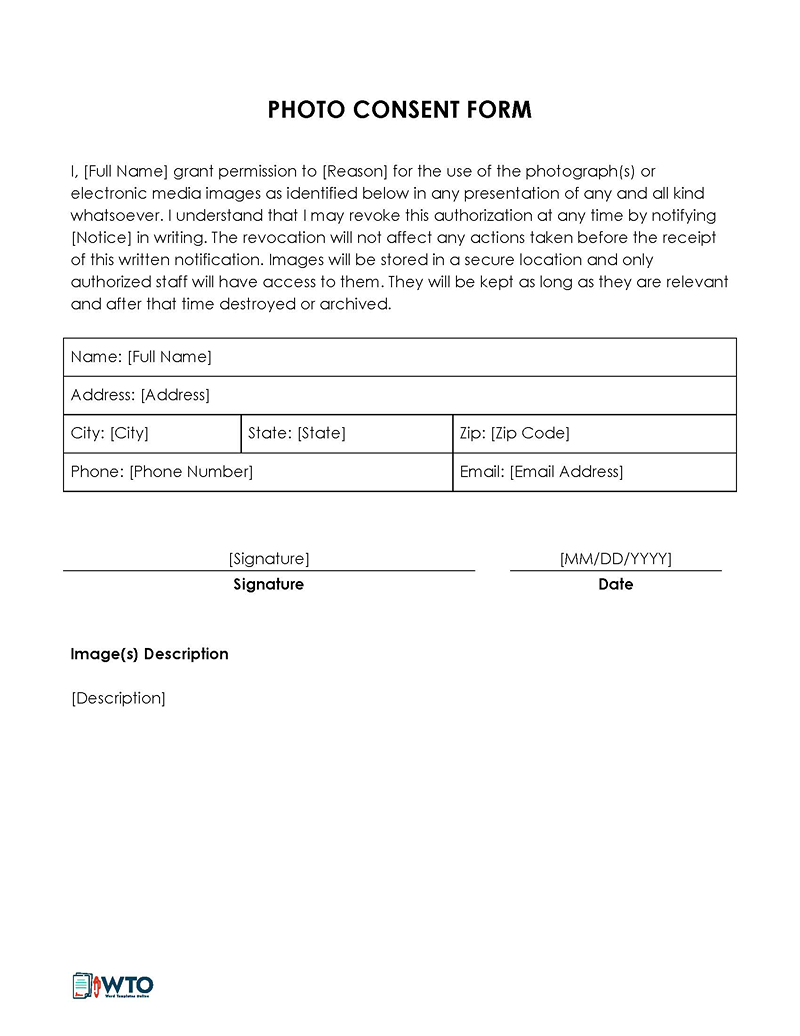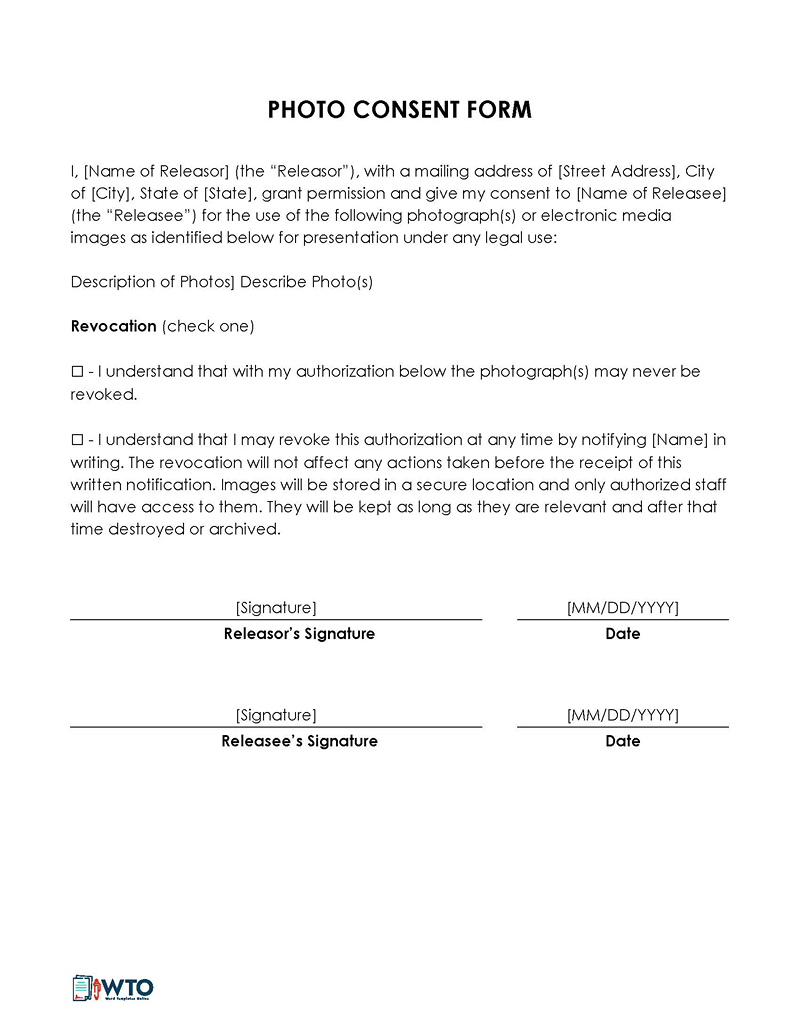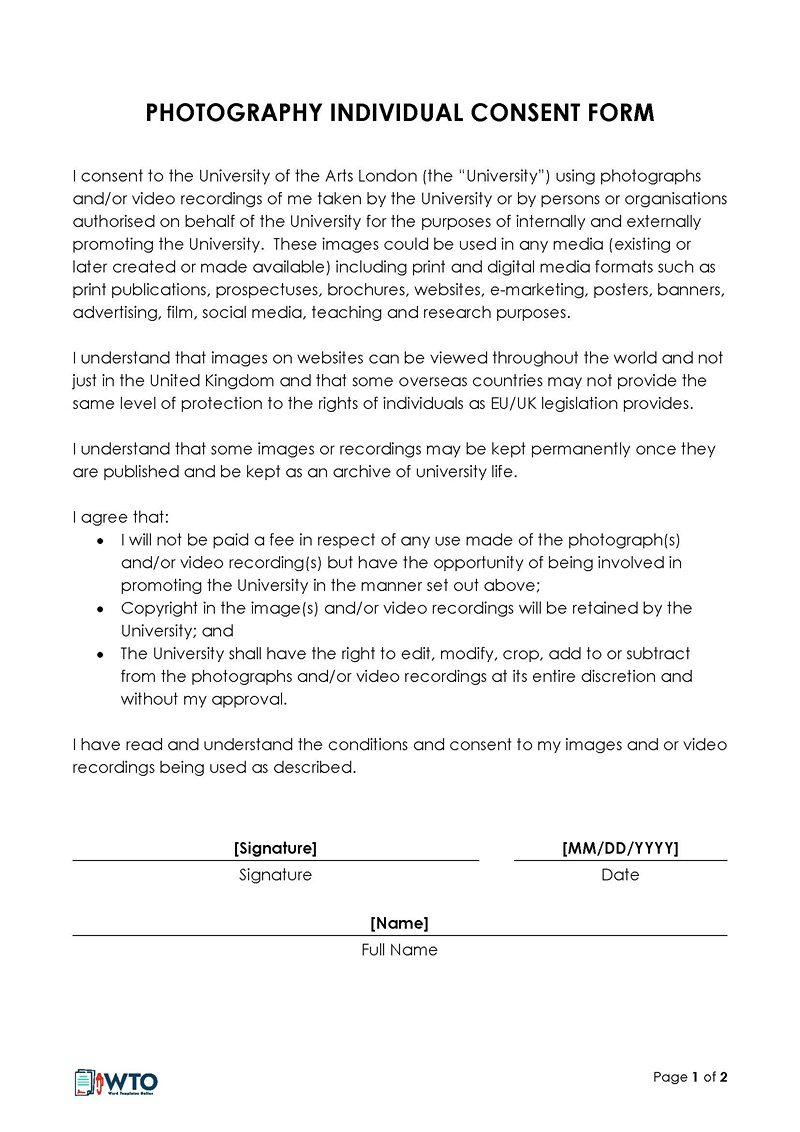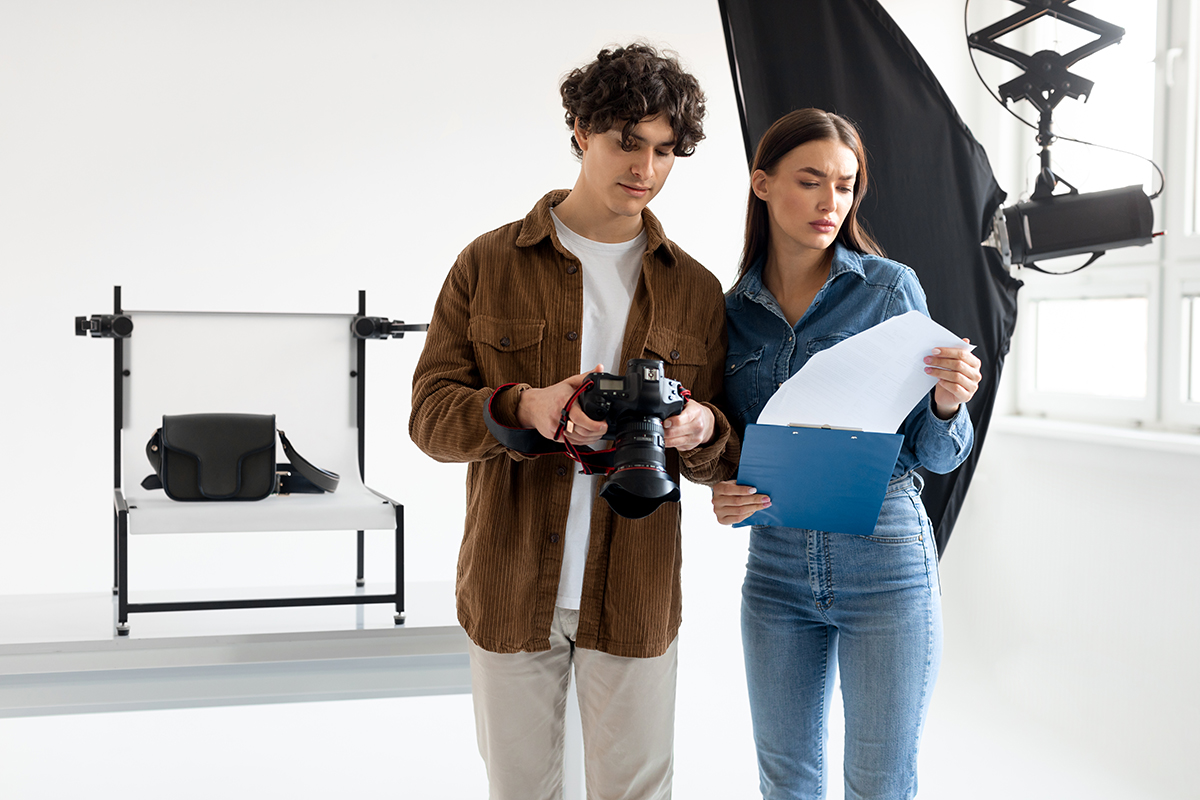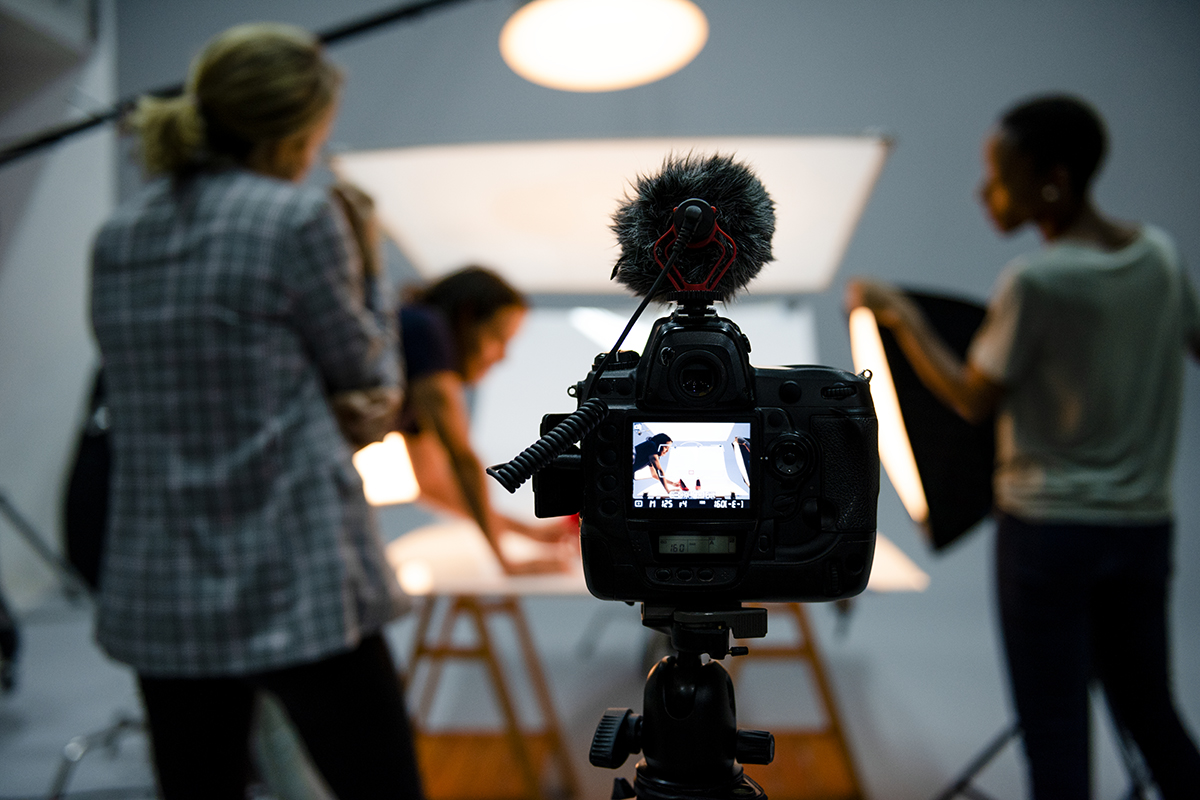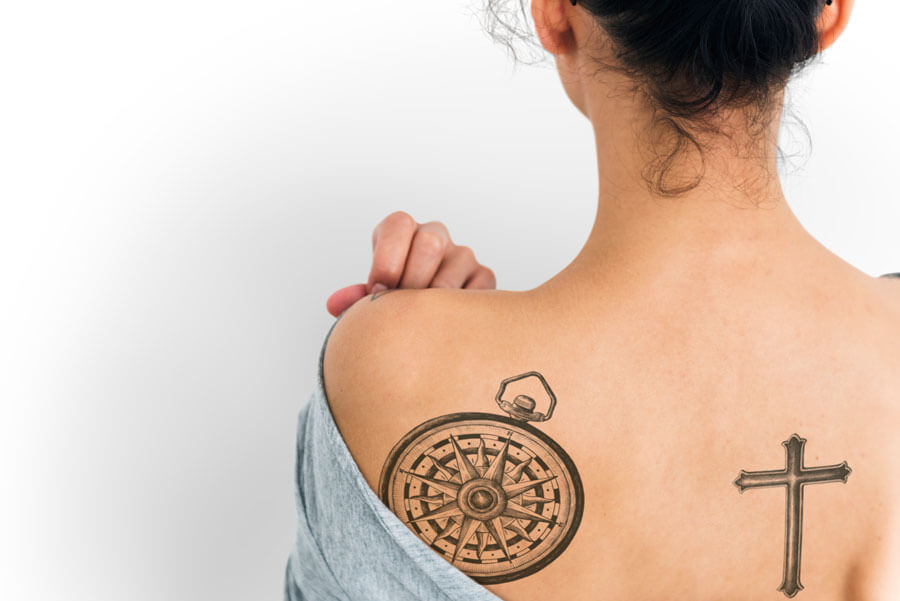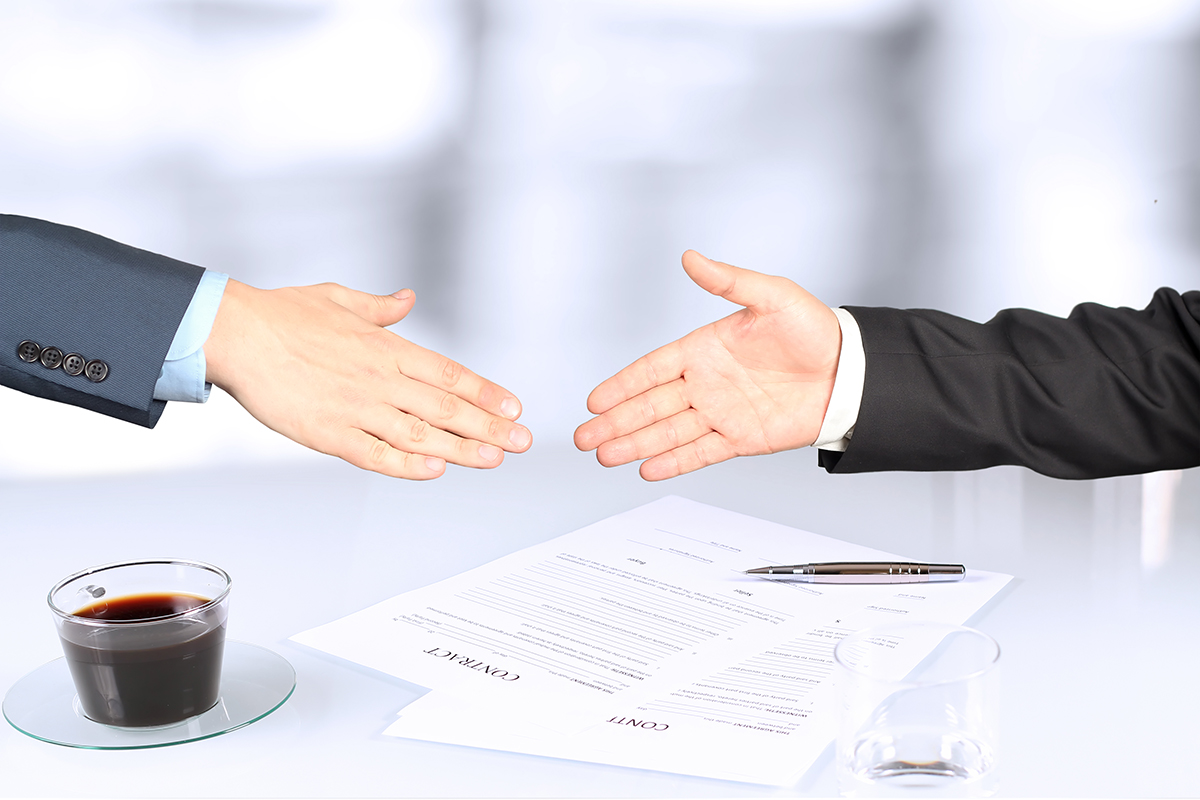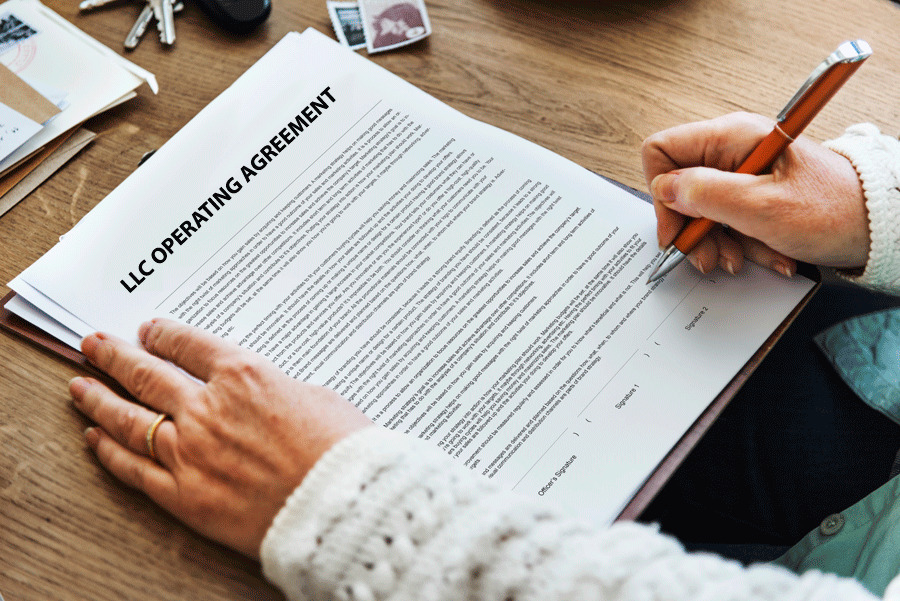A photo consent form is a legal document that is used to obtain permission from an individual or their legal guardian to take, use, or publish their photograph or image.
The form is particularly important in the context of privacy laws, which vary by jurisdiction but generally require that individuals have a reasonable expectation of privacy and control over their own image. The form typically outlines the purpose for which the photograph or image will be used and may include details about how the photograph or image will be distributed, reproduced, or displayed.
The form may also be referred to as a:
- Publicity Release Form
- Personal Image Use Agreement
- Photography Waiver Form
- Image Release Form
- Visual Content Authorization Form
- Digital Media Release Form
The form also gives the owner of the pictures the right to withdraw consent at any time if it includes a revocation clause. However, if the form lacks this clause, the owner may not be able to withdraw consent once the pictures have been published or used.
This article discusses the significance of using a release form to obtain consent to publish photos, who needs this form, and when it can be used. Various types of these forms and a guide to making one have also been provided, along with free templates.
Free Templates
If the above mentioned process seems complex, use one of our free, downloadable templates. These are easy to customize and will help you save time should you need to obtain the consent of multiple subjects.
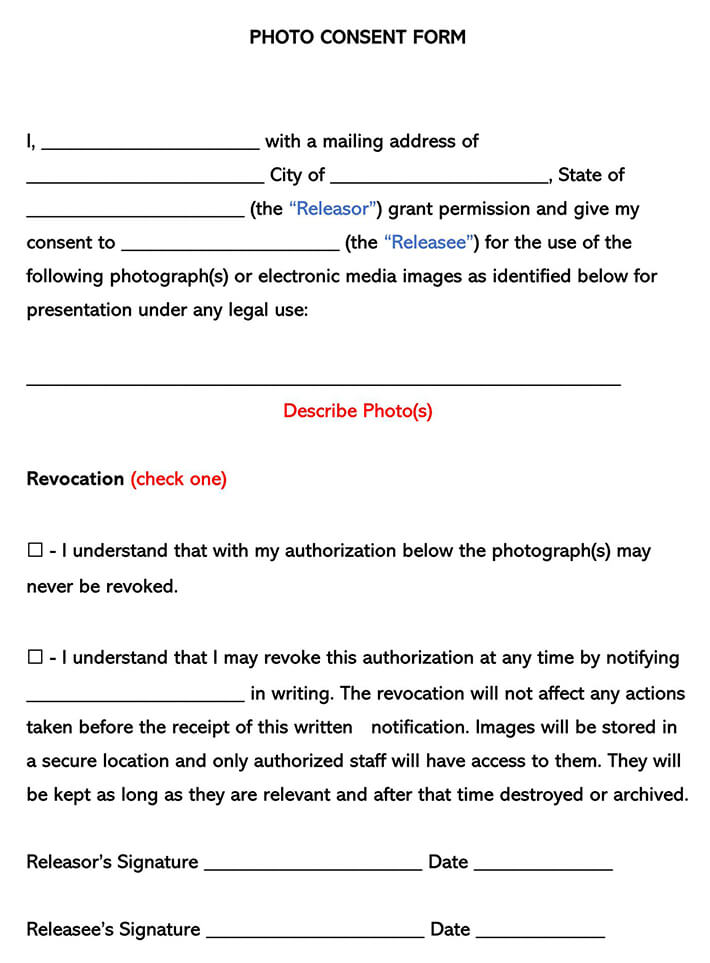
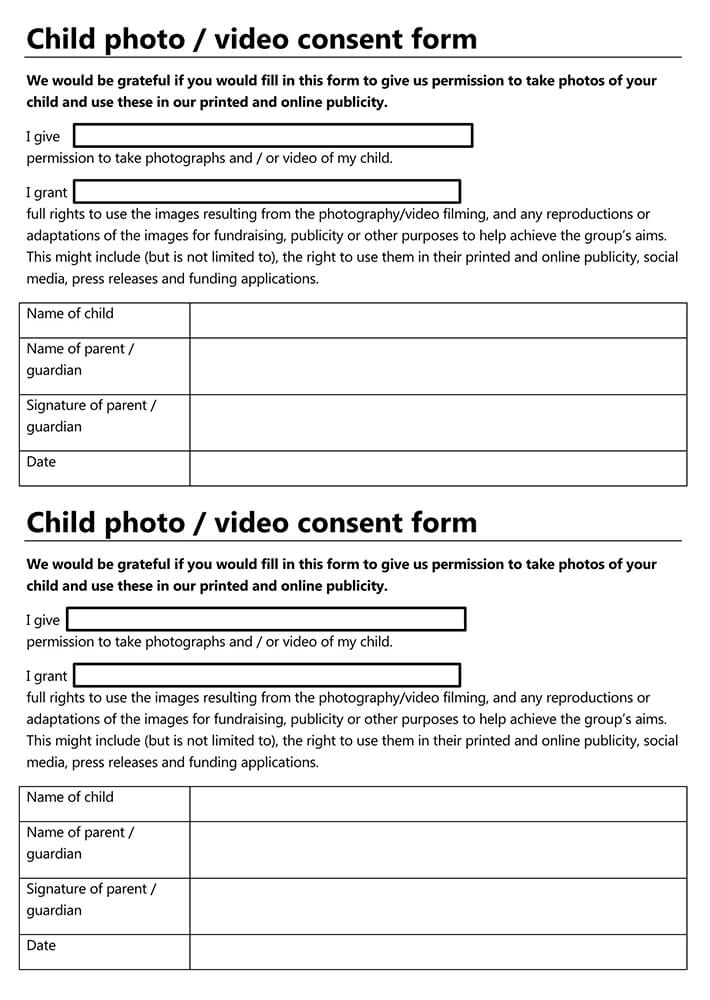
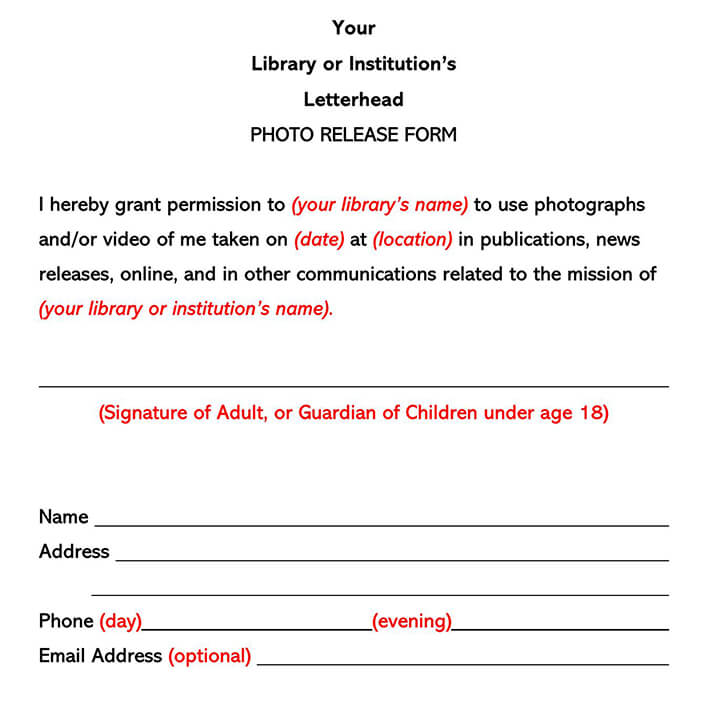
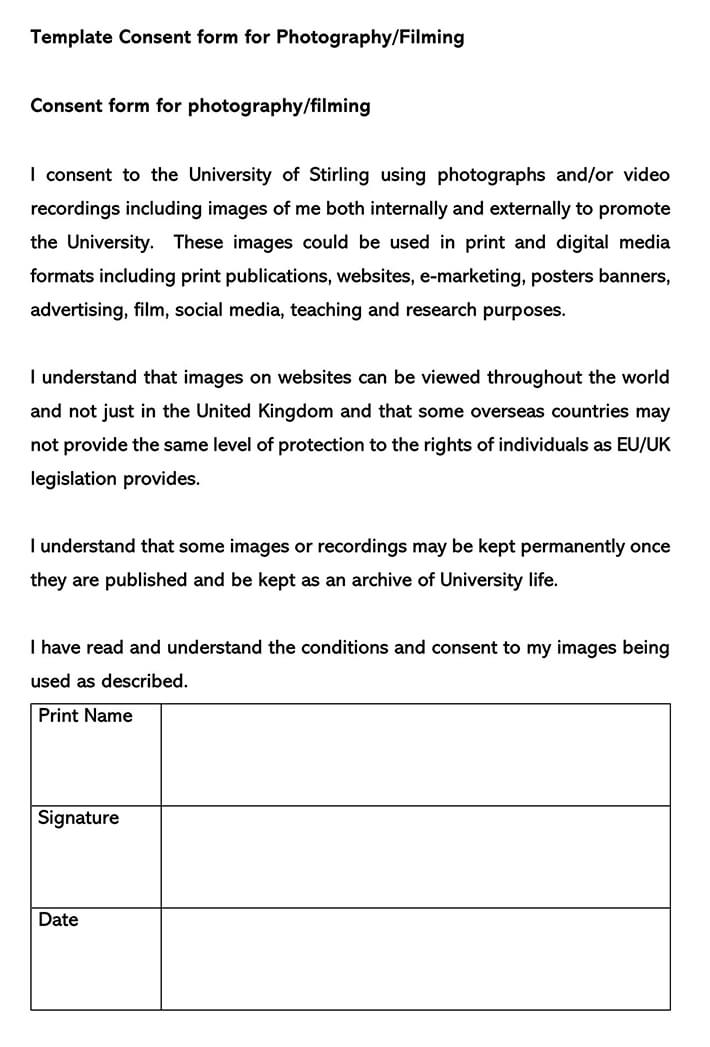
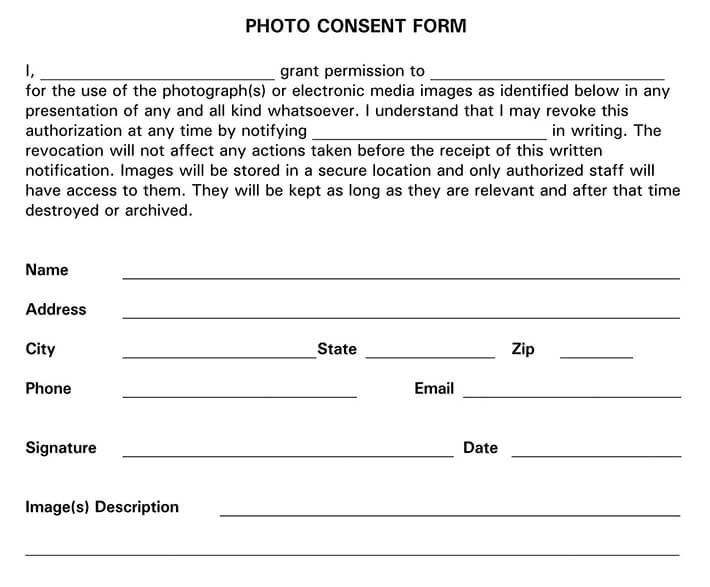
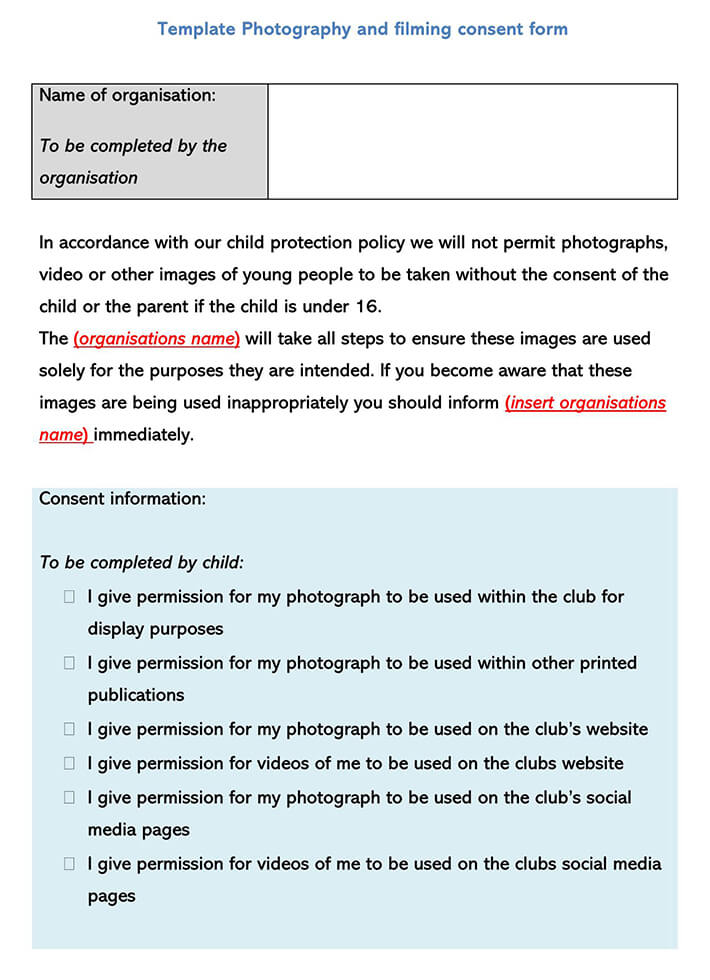
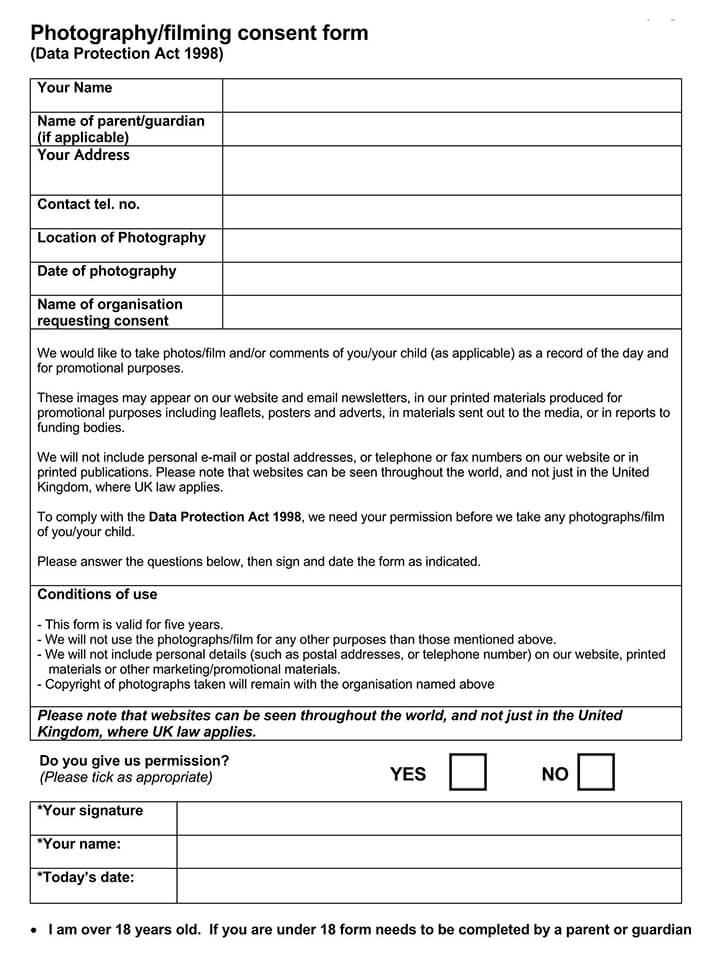
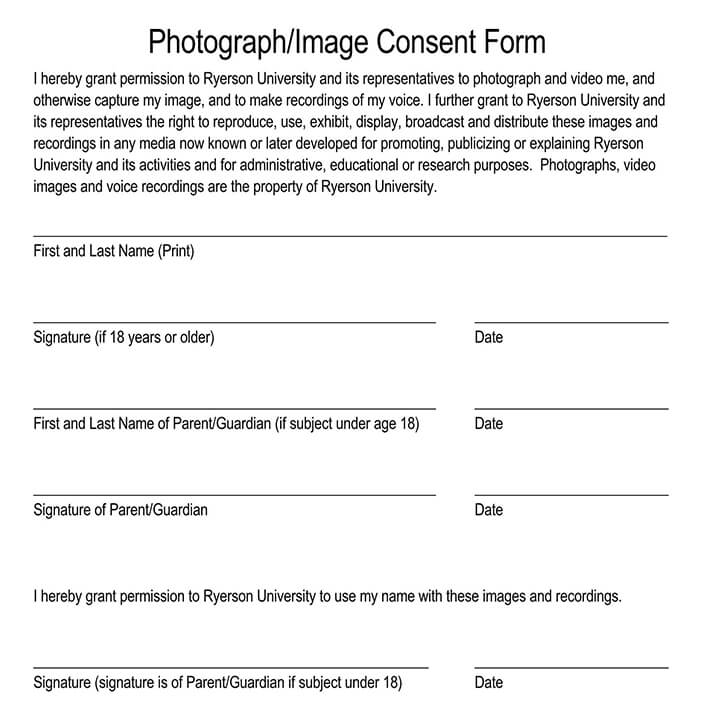
Significance of Using a Consent Form for Images
Using a photo consent release form is significant because it helps to protect the rights and interests of all parties involved in the use of an image or photograph. There are several reasons why such permissions must always be obtained, such as:
- For the person or entity using the photograph, having a signed release form can help to prevent legal disputes and ensure that they have the necessary permissions to use the image in the way that they intend.
- For the individual or entity whose image is being used, a release form provides a level of control and protection over their image, including how it is used and who has access to it.
- Without such explicit permission, there is a risk that an individual or entity could use an image in a way that is unauthorized or not in line with the original agreement, which could result in legal disputes, damage to reputation, or financial loss.
- Additionally, a photo release form can provide clarity and transparency around the intended use of the image, including how it will be distributed, reproduced, or displayed.
Who Needs a Photo Release Form?
Photo consent release forms are necessary for anyone who intends to use someone else’s image or photograph in a way that could be considered commercial or public.
This includes:
Photographers
Photographers who take pictures of individuals, groups, or events in a commercial context are required to obtain a signed photo release form before they can use the images for any commercial or promotional purposes.
If a photographer plans to sell or publish their photographs or images, they must obtain the necessary permission from the subject(s) of the photo.
Event organizers
Event organizers may need to obtain photo release forms if they plan to use photos or videos taken at their event for promotional or commercial purposes. This may include photos of event attendees, performers, or guest speakers.
Businesses
Businesses may need to obtain photo release forms if they plan to use photographs or videos of their employees, customers, or products for promotional or commercial purposes. This may include using images on a company website, social media, or in advertising.
Individuals
Individuals may also need to obtain photo release forms if they plan to use images of other people in a commercial or public context. For example, if an individual plans to use a photo of a friend or family member in a marketing campaign or on a website, they may need to obtain permission first.
Copyright Vs. Consent Form
While copyright and a form of consent may be related, they serve different purposes. A publisher’s copyright on an image is unaffected by this form. A copyright is a legal document granted to the author of an original literary, artistic, or musical work to control how that work is used and distributed. The author has the exclusive right to distribute, reproduce, showcase, perform, and create derivative material based on the original work. The form, however, is a legal document that outlines an agreement between two or more parties. The purpose of this document is to obtain permission from one party to use or share information or materials related to another party.
Minor Vs. Adult Photo Consent Form
A minor’s consent form is a legal document that is signed by the parent or legal guardian of a minor, permitting the minor’s photograph to be taken, used, or published. An adult’s consent form is signed by someone who is capable of giving legal consent for their photograph to be taken, used, or published. The key difference is that minors are not legally capable of giving consent on their own, so a parent or legal guardian must sign on their behalf.
How to Make a Photo Consent Release Form: Information to Include
Drafting a release form to publish a photo is a relatively simple process. It is essential to consider how you intend to use the photos before you draft the form.
Listed below are the important components to include:
Identity of the party giving permission
First, present the names of the parties permitting the use of an image. This is the individual or organization that has the legal authority to consent to the use of the image.
Information about the individual or entity receiving permission
Specify your name, phone number, and physical address.
Details about images being produced
This section of the form concisely describes the specific images the owner allows to be published. Include the photographer’s name, the subject or subjects of the photos, and when they were taken. You may also define the types of images that you will publish, whether they are videos, still images, or a mixture of both.
EXAMPLE
Close-up family shots captured by Amanda Hailey on June 3, 2023
Duration of the photo’s use
This section of the form should specify if you will be given indefinite access to the photos or whether they will be deleted or destroyed after a certain period.
EXAMPLE
I understand that the photographs may be used for an indefinite amount of time unless otherwise specified in writing. However, I reserve the right to revoke this consent at any time by providing written notice to Zeus Gym.
Conditions of use
Include the purpose of the photograph in the document to ensure that the individual understands how the photograph will be used. It should clearly state the intended purpose of the photograph, such as commercial use or personal use, and provide details about how the photograph will be distributed, reproduced, or displayed. This helps the individual make an informed decision about granting permission for the photograph’s use.
EXAMPLE
I consent to Zeus Gym using my likeness in photographs publicly to promote its new fitness program. These photos could be utilized for marketing purposes on banners, websites, posters, and other print and digital media.
However, these photographs shall not be:
- used in any manner that would be considered offensive, obscene, or indecent.
- altered, manipulated, or edited in any way without my prior written consent.
Ownership
Ownership refers to who has the legal right to use and control the photograph or image in question. In most cases, the photographer or the person taking the photograph owns the copyright to the image, unless they have assigned or transferred their rights to someone else.
Ownership should be clearly specified in a photo release agreement to avoid confusion or disputes. The agreement may state that the photographer retains ownership of the photograph or image but grants the individual the right to use the photograph or image for a specific purpose, such as personal or commercial use.
Alternatively, the agreement may specify that ownership of the photograph or image is transferred to the individual, giving them full rights to use and control the image as they see fit. It is important to establish ownership and usage rights clearly in the agreement to prevent any misunderstandings or legal issues in the future.
Revocation clause
Revocation refers to the action of withdrawing or canceling a previously given consent or permission. In the context of a photo release form, “revocation” means that the individual who signed the form may withdraw their permission for the use of their photograph or image at any time. This means that they may request that the photographer, event organizer, or business stop using their photograph or image and remove it from any existing materials or platforms.
Claims
Claims refer to any legal claims or liabilities that may arise from the use of the photograph or image. In a photo release form, it is important to include a clause that states that the individual whose photograph is being taken or their legal guardian releases the photographer, event organizer, or business from any claims or liabilities arising from the use of the photograph or image. This helps protect the photographer, event organizer, or business from legal disputes or liabilities that may arise from the use of the photograph or image.
Additionally, it is recommended to seek legal advice to ensure that the claims clause in the form is legally sound and complies with relevant laws and regulations.
Compensation and royalties
If the individual is being compensated in any way for their participation in the photograph, this should be clearly stated in the form. It should specify the amount of compensation, as well as any conditions or restrictions associated with the compensation.
Royalties or other forms of compensation for the use of a photograph are not always mentioned in the form, but it is advisable to do so if applicable. If the individual whose photograph is being taken is entitled to receive royalties or other forms of compensation based on the use of their photograph, it is important to be transparent about the compensation offered and to ensure that all parties involved understand the terms of the agreement before signing it.
It is also recommended to seek legal advice to ensure that the form complies with relevant laws and regulations regarding compensation and royalties for the use of photographs.
Specify jurisdictional laws
The state, federal, or city laws under which the form is signed should be stated based on the jurisdiction in which the photograph was taken. These laws and jurisdictions can be referred to in the event of any legal dispute.
Termination
This clause should specify the circumstances under which either party can terminate the agreement and the steps that must be taken to do so. For example, if either party breaches the terms of the agreement, the other party may terminate the agreement by providing written notice.
Additionally, the termination clause should outline any obligations that will survive termination, such as confidentiality provisions or intellectual property rights. Including a termination clause in the consent form can help ensure that both parties understand their rights and obligations under the agreement and minimize the potential for disputes or misunderstandings.
Signature and date
The signatures of both parties must be included on the form for it to be considered legally binding. Include space for the names, contact information, and signatures of you and the owner of the photograph. If the individual is a minor, their parent or legal guardian must sign it. Specify the date when the form was signed to have a definite start date.
You can also include a checkbox followed by the statement:
“I have read and understood the terms above,” for the responding party to checkmark.
Expiration date
Specify the expiration date after which the consent granted will no longer be valid. It is significant because it establishes a timeline for the use of the image and ensures that the individual’s consent is not perpetual. An expiration date can be especially important if the photograph is being used for a specific event or campaign.
EXAMPLE
If a company wants to use an individual’s image in a marketing campaign that will run for a limited time, it may be appropriate to include an expiration date in the document to ensure that the individual’s consent does not extend beyond the end of the campaign.
This form is valid until [date], and after that, all rights granted herein will be terminated.
However, this provision may not be generally applicable in all situations, and the specific terms may vary depending on the purpose of the use of the photos.
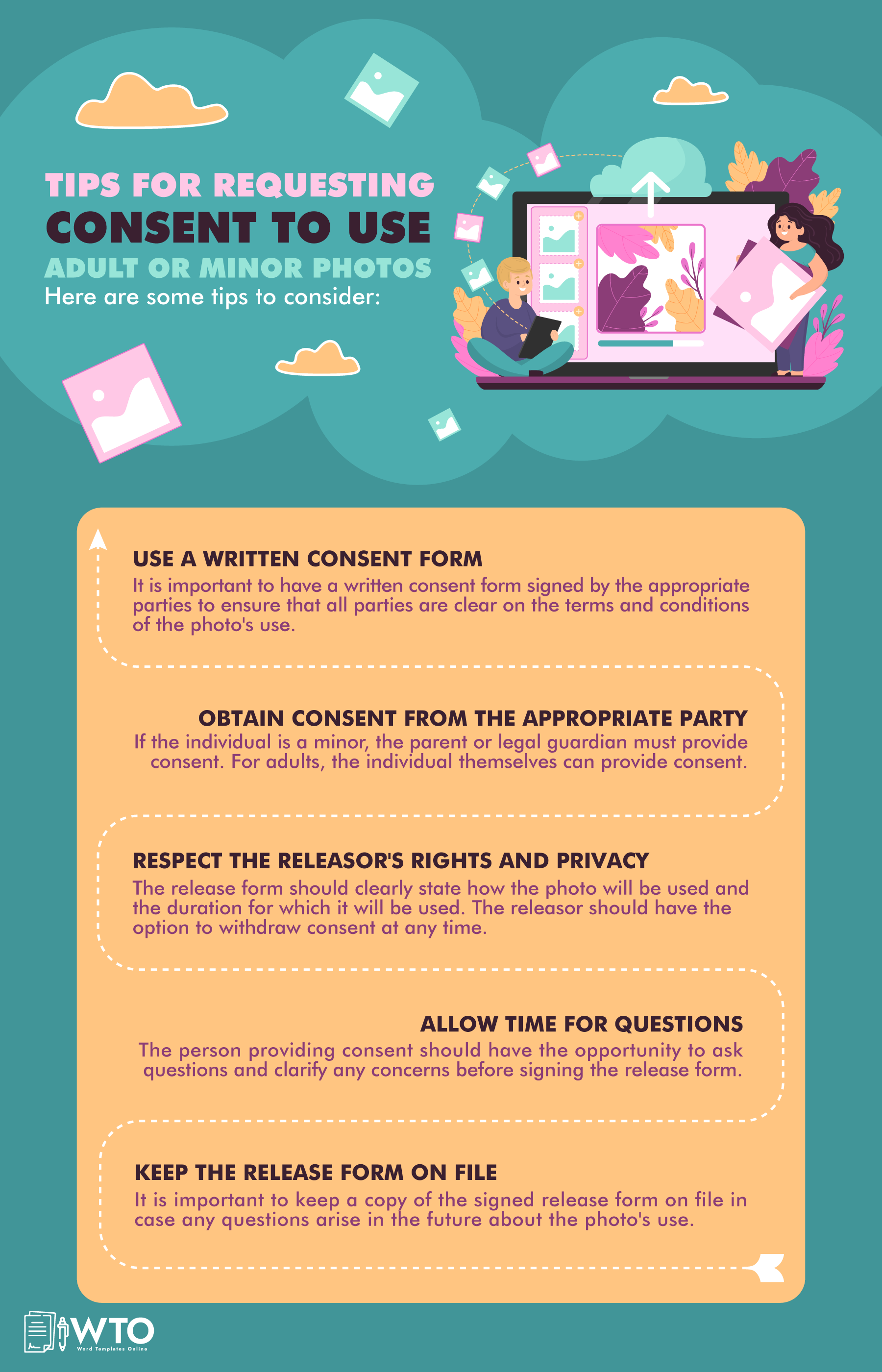
Types of Photo Release Forms
Different situations necessitate the use of particular forms of consent when publishing photos. The conditions for use may vary depending on the photos’ purpose and subjects. Below are the frequently used types of forms:
General photo release form
This type of form is used to obtain permission for a photograph’s use in any context, such as commercial or personal use.
Model release form
Model release form is specific to photographs of individuals and is commonly used in the fashion and entertainment industries. It grants permission to use an individual’s image for advertising, promotion, or other commercial purposes.
Property release form
A property release form is a type of legal document that grants permission for the use of images that feature private property. This form is used by photographers and filmmakers to obtain permission to use images of personal property in their work. Personal property can include things such as artwork, sculptures, furniture, and other objects that are owned by an individual or business.
Location release form
Location release form is used to obtain permission to photograph a specific location, such as a building or a public space.
Event release form
This form is used to obtain permission to photograph and use images of attendees at a specific event, such as a concert or festival.
Frequently Asked Questions
While it is not always necessary to have a lawyer create a release form, it is highly recommended, particularly if you will use the photos commercially. A lawyer can help ensure the document contains the necessary clauses and protects you and the consenting party. A lawyer also ensures the form complies with relevant state and federal laws or regulations, especially those related to privacy or data protection.
A verbal agreement may suffice in situations where it is not necessary to obtain written consent, such as filming during a spontaneous meeting or informal setting. While a verbal agreement may be acceptable in some cases, it is recommended to have a signed document to ensure the terms and conditions are clearly defined and agreed upon by all entities involved.
The length of time a consent form should be kept depends on various factors, such as the applicable laws and regulations, the purpose and context of the photographs, and the organization’s policies. Generally, it is recommended to keep the forms for as long as the photographs or images are being used, distributed, or displayed. If the photographs or images are no longer in use, the forms can be kept for a reasonable amount of time, such as a few years, in case of any potential legal disputes or claims. It’s always best to consult with a legal professional to determine the appropriate retention period for the forms in a specific context.
